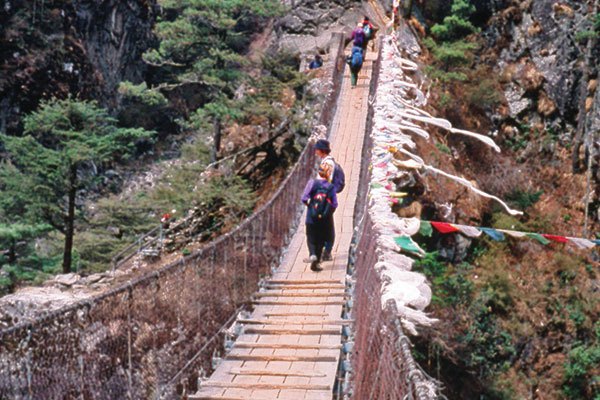The picturesque Sherpa village of Dingboche near Mount Everest had three water sources, and my bacterial test of one of them — an open ditch — showed the presence of coliform bacteria.
A few days later I revisited the town and wanted to make sure that water wasn’t being consumed without treatment. I entered the lodge (restaurant/hostel) near the stream and spoke to a group of men wearing Western clothing, one of whom said he spoke English. After I explained the water wasn’t safe to drink, a different Sherpa replied, “Well, we always boil the water from that source, but maybe you can tell us whether boiling at this elevation is sufficient to kill the bacteria?â€
After a quick double take at the sophisticated question, I was able to summon up enough technical background to assure them that boiling was, in fact, sufficient treatment.
Climbing in research
I’ve been fascinated for most of my life by Mount Everest, faraway places like Tibet, Buddhist culture and mountaineering. Those passions came together when I was able to visit both sides of the world’s highest peak with commercial climbing expeditions in 1994 and 2000 as a “researcher.â€
It would have cost tens of thousands of dollars and a large chunk of my life to make any serious attempt to actually summit, so I was content to accompany the serious climbers and try to give something back to the peoples and natural environment near Everest.
In 1994, I went with Eric Simonsen’s International Mountain Guides to Tibet base camp, where I built a toilet for the expedition that was a prototype of one later built at Camp Schurman on Mount Rainier. My work for the National Park Service at Mount Rainier had led to my acquaintance with Eric and the invitation to do this environmental project on Everest.
Drive to 17K feet
Tibet is a much different environment for climbers than the route through Nepal that more people are familiar with. In Tibet, it’s possible to drive to Base Camp at 17,000 feet instead of trekking on foot for days. On this trip, I also had the opportunity to backpack some rather easy slopes all the way to Camp 3 at 21,500 feet and so get relatively close to the actual highest point of the world.
Some years later, as the Everest Environmental Expedition of 2000 was casting about for projects, I suggested a project and was invited to join their expedition as well.
The toilet situation at Base Camp in Nepal was under good control by new regulations, but there was very little information about water quality there and in the nearby villages. I was able to collect sufficient lab equipment to run about 150 tests of water sources for fecal coliform to look for contamination by human waste.
The tests indicated that most water sources in use were relatively pure but certain sources needed some sort of treatment, such as boiling, to keep climbers and villagers safe from diseases.
These trips offered close examination of at least two highly disparate cultures. One is the dangerous, competitive and highly focused world of high-altitude mountaineering, and the other is the centuries-old devout Buddhist lifestyle of the high Himalaya, which flourishes in Nepal and Tibet despite persecution by the Chinese government.
I would be happy to share my images and insights with anyone interested.
About the presenter
Roger Drake has had a lifelong fascination with Mount Everest, the people and culture of Tibet, and mountain climbing. But the passion to actually climb Everest never grew to the point of his sacrificing a large portion of his life and finances to join a commercial climbing expedition.
In 1994 and 2000 as a researcher, he was able to travel with commercial climbs to the base camp and partway up the world’s highest peak, through Tibet and later Nepal. His work for the National Park Service provided the background he needed to complete environmental projects in conjunction with these expeditions and allowed him the satisfaction of “giving something back†to the natural environments and cultures on the north and south sides of the peak.
Both trips were made possible by his association with professional mountaineers while he was employed at Mount Rainier. Originally from Poulsbo, Drake retired in 2007 and presently lives near Port Angeles.



